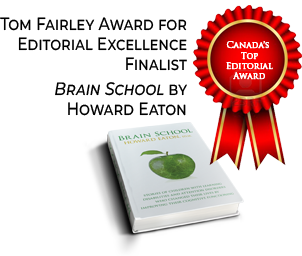
Contents:
- Realism through artifice
- Dialogue’s primary purpose
- The three other purposes of dialogue
- Distinction between characters
A few months ago, I got a little ahead of myself by writing a post on how to write authentic foreign accents and dialects in your fiction dialogue. Today, I’m going back to square one to discuss the basics of writing dialogue in fiction. This will be the second post in a five-part series because there’s lots more to cover.
Writing effective dialogue for your fictional characters is just one of many important skills you’ll need to master if you want to be a successful fiction writer. For most writers, it’s not a skill that comes naturally or instinctively. Just like other fiction-writing techniques, writing effective dialogue is a skill that needs to be learned through plenty of study and practice. (Memoir writers, note that these dialogue techniques may also apply to you if you’re using dialogue; memoir is similar to fiction in a number of ways including the use of dialogue.)
1. Realism through artifice
If your written dialogue sounds exactly like two people talking in real life, you’re making a mistake. When writing fictional dialogue, the point is to convey the impression of real-life speech, not mirror it. It should sound natural and realistic to the reader’s “ear,” but it should never be realistic. Dialogue in fiction is artifice, not realism. You need art, craft, and skill to write authentic-sounding dialogue.
The next time you’re sitting in your favourite coffee joint, take a few minutes to listen to people around you talking. When people speak in real life, they use a lot of filler words such as uh and um, like and well. In particular, kids these days—and I mean grown-up kids too, in their twenties and beyond—punctuate their spoken sentences with endless likes. “Well, uh, I think I’ll, like, call my parole officer so, like, I can get it over with. Like, I’d rather be having a root canal, eh?” (I’m exaggerating to make a point, but you get the idea.) Even I’m guilty of it. The word like as filler creeps into my speech from time to time, but it, like, can hardly be avoided in today’s culture, you know?
In real life, people don’t speak proper English. They interrupt each other, hem and haw, use those filler words, hesitate, speak in incomplete, grammatically incorrect sentences, repeat themselves, and jump from one unrelated thought to other. However, when writing your fictional dialogue, what’s key is to convey real-life speech without resorting to an excess of boring filler. Effective fiction dialogue should be a balance between how people naturally talk and more formal narrative and expository writing, using reasonably good but relaxed grammar for the most part, but still keeping the tone of the dialogue true to real life. You should neither write as lazily as people speak in real life nor as formally as you would write in the rest of your story. A balance works best.
Yes, this all takes work and practice. One of the most effective things you can do to improve your dialogue writing is to read it out loud, or have someone else read it to you. Record yourself (or the other person), and listen back carefully for stiffness and unnaturalness. A further technique is to first write all the dialogue in perfectly grammatically correct sentences. Then, again, read them aloud—you’ll quickly see whether they feel stilted or awkward. Now go back and rewrite, toning down the language, removing some of the words, and adding a little filler without changing the meaning of the sentence. Important: be sure the voice, tone, filler words, and education level you use are specific and unique to each individual character. In real life, no two people talk in exactly the same way (more on this later). With practice, by listening and observing, and by reading aloud, you’ll begin to see the difference between formal writing and the spoken word.
2. Dialogue’s primary purpose
One of the tougher problems novice fiction writers (and experienced writers, too) face is deciding when to write dialogue instead of narrative. When is the best time to stop the narrative flow and inject some dialogue into the mix? When making this decision, it’s best to keep in mind the purposes of dialogue. Dialogue has several concrete purposes in fiction besides just randomly having characters talk to break up the narrative.
The number-one purpose of dialogue is to heighten the emotional stakes and increase the conflict and tension. These two elements should always be part of a well-plotted novel. Whenever the drama between two characters is escalating emotionally, that’s the time to break off the narrative and inject some dialogue. It needn’t be a major crisis; any dissonance or small disagreement in the scene will usually work better as dialogue. If the scene has only one character experiencing conflict—internal or external—this can be shown through the use of the character’s direct thoughts, sometimes called internal dialogue. (I discuss internal dialogue at length in the fifth article in this series here.)
Conflict is the basis of all good fiction, as explained in my blog post What is plot? Pinning down fiction’s elusive structure. Without conflict, you have no plot, just the events out of somebody’s diary. Similarly, conflict is the basis of all good fiction dialogue. Without hints of conflict, you have a ho-hum everyday conversation. If you’ve studied the craft of writing, you probably already know that real-life events don’t usually make for good fiction. In our real lives, we attempt to minimize tension and conflict. In your fiction, you need to maximize tension and conflict if you want to keep readers turning your pages. Compare the following two snippets portraying the same scene, the first mainly narrative (telling), the second mainly dialogue (showing):
- Narrative
Micaela was furious with John for forgetting the map at the gas station. Time was critical, and now they were lost. She yelled at him, telling him what an idiot he was; not only were they pressed for time, but for their plan to work, they needed the map for the rest of their journey. She swore that she would never again leave him in charge of crucial details like this.
- Dialogue
John was driving too slowly. “Step on it,” Micaela said impatiently. “This isn’t going to work if we’re late.”
“I—uh—I’m not sure where we are,” he faltered.
“What? Didn’t you study the map ahead of time? Where is it? Let me see.”
“I don’t know. I might’ve left it at the gas station—”
“What!” She could scarcely believe what she was hearing. “You idiot! How could you be so stupid? We need that map.”
As if trying to infuriate her more, he didn’t respond, just continued staring at the road.
“We’re going to be late now. This is beyond ridiculous,” she said, seething.
Still he didn’t react.She grabbed his shoulder, shaking him. “Our plan is ruined, and it’s all your fault. I’ll never leave you in charge of anything important again.”
Comparing the two, can you see how much stronger and more powerful the second scenario is, using mostly dialogue? Showing, using dialogue, takes more words, but they are often worth it for their emotional impact.

3. The three other purposes of dialogue
Besides adding tension to the scene, dialogue has three further purposes. After writing each section of dialogue, first make sure you’ll pull readers’ emotional strings by injecting some elements of conflict and struggle. Then stop, reread it, and ask yourself:
- Does it advance the plot?
- Does it provide information or backstory?
- Does it help to develop your character(s)?
If it doesn’t fulfill at least one of these three other purposes, it probably needs to be axed or the information would work better as a narrative summary.
One excellent test is to ask yourself whether the plot would be affected if you removed the line or lines of dialogue in question, perhaps the entire conversation. If the story will still make sense without this particular exchange, then be ruthless and scrap those lines or the whole conversation. If you don’t do it, your editor likely will.
- Narrative purpose – advancing the plot. Think of the narrative as the action that moves the story ahead. Each conversation between two or more characters should move the narrative story forward in some way. If two characters are idly talking about the weather forecast or what they ate for dinner last night or their mother’s hip replacement, it’s unlikely (though not impossible) that those conversations are advancing the plot, pushing the narrative action ahead, or urging the reader to keep on turning pages. If so, cut or revise.
- Expository purpose – providing information and backstory. Exposition can be thought of as exposing facts, information, and descriptive details, including backstory. Sometimes authors will write an entire flashback scene just to show a bit of backstory, which is often a poor idea. Any more than a few well-chosen flashbacks can spoil a good story. One way to avoid flashbacks is reveal the backstory with some expository dialogue.
Let’s say you have a recently married couple in conflict. Instead of writing an entire flashback scene about their wedding that took place in the tropics but that has nothing to do with the main plot, simply have your protagonist provide the backstory by saying something about it:
“Remember, it wasn’t me who wanted the wedding on a sweltering atoll in the South Pacific. It was your lousy idea! And now you’re suffering the consequences. Why should I feel sorry for you?”
In a few sentences, by showing backstory in the dialogue, we’ve just eliminated the need for an entire flashback scene on a desert island that would have had little to contribute to the forward motion of the plot. As a bonus, we’ve also created tension and conflict, and we’ve given some hints about the character’s personality—which is the final aspect of dialogue’s purpose and my next point.
Delivering information, history, and backstory through the use of dialogue can be an effective way to show it, not tell it in the narrative. Showing is often preferable, as too much telling sometimes results in boredom for the reader. (For more on showing vs. telling, see my article Why “show, don’t tell” is the big myth of fiction writing.) However, be cautious of giving overly long descriptions and information dumps in your dialogue—that actually turns the writing into telling. I’ll discuss this problem more in Part IV in my series on dialogue.
- Conveying character. While creating conflict and tension, advancing the plot, and delivering information and backstory to the reader, dialogue should serve a final purpose: it should convey character. By this, I mean that it should add to the development of your characters by showing their individual, unique personality traits. Through dialogue, you can show anger, fear, empathy, passion, apathy, tolerance, introvert or extrovert tendencies, and a host of other human qualities that contribute to well-rounded, interesting, and unique characters.
In real life, we each have our own different vocabularies and quirks of speech. You can avoid having your characters all sound alike by keeping lists of words and expressions unique to their individual personalities. For example, I have a tendency to say “good grief,” a banal, old-fashioned interjection that nonetheless helps to characterize me. My next point goes into more detail about how to create characters with distinct personalities.
- Breaking rules. Now that you know the four purposes of dialogue, make sure almost every line of your dialogue fulfills at least one of these purposes, preferably more. Notice I just wrote almost: there are always exceptions, and rules are made to be broken occasionally. In the interests of good pacing and flow, not every single word of dialogue needs to fulfill these purposes all of the time. Sometimes you need to use a little filler as beats in your writing. (In fiction, a beat is a word or phrase or sentence that creates a subtle pause in the action or speech and helps with the rhythm, pacing, and flow of the sentence or paragraph.) Use expletives, interjections, and filler words and phrases judiciously to add subtle pacing and flow to your dialogue.
4. Distinction between characters
Make sure each of your characters has a distinct, unique voice. As I mentioned, no two people on the planet have identical speech patterns. A giveaway of weak writing is a bunch of characters who all sound the same—and, no surprise, you’ll usually find they all sound just like the author. You’ll show abilities of a skilled writer if you ensure each of your characters has their own individual speech quirks and idiosyncrasies. These will depended on the characters’ age, gender, ethnicity, geographic location, socio-economic background, education level, and personality type. For example, you wouldn’t have a five-year-old child speaking the same way as a 20-year-old, and a 20-year-old wouldn’t speak the same way as a 60-year-old. Different generations have different lingo, as do all the other groups I mentioned. Some characters may be loquacious; others may be reserved or uncommunicative. Others may be introverts or extroverts. Be particular about the language style of each of your characters.
The best way to do this is to create character sheets. Draw up a sheet for each character, both major and minor ones, and list not only details of their backgrounds, personality traits, and physical characteristics, but idiosyncrasies of their speech including slang, expletives, clichéd or unusual expressions, and filler words. Along with the more clichéd idioms, invent some creative, new expressions for some of your quirkier characters. A friend of mine likes to say “Holy chickens!” when showing astonishment. I love that!
Caveat: Use slang, expletives, filler, and clichés sparingly. Overuse will distract your reader, jolting her out of your fictional world, which is the last thing you want to do.
Finally, if some of your characters have foreign accents or speak in a particular dialect, portraying their voices subtly and authentically can add a great deal to their characterization. Use moderation, and do your research to make sure you’re representing the accent accurately without turning your character into a caricature. For an extensive look at writing foreign accents and dialect, see my first blog post in this series from March 2014, How to write authentic dialect and foreign accents.
In summary
In this article, I’ve discussed the need for artifice to create realism, the four purposes of dialogue (creating emotional tension and conflict, advancing the plot, providing information and backstory, and conveying character), and how to make your characters’ voices unique and distinct. The next few posts will cover the nuts and bolts of dialogue writing, including:
- Ratio of dialogue to narrative
- Opening pages
- Dialogue tags (attributions)
- Action tags or beats
- Tom Swifty adverbs
- Conciseness
- Use of contractions
- Punctuation
- Info-dumping dialogue
- Writing internal monologue – direct and indirect thoughts



15 Responses
Fantastic blog post, Arlene. Very clear, and spot-on.
Thanks, Sophie! Your comment means a lot to me. This post and the ones that are to follow took a lot of time and research while I’ve been under tight deadlines with work. I’m glad I managed to make my points are clear.
Arlene, thanks for such a detailed and interesting post about dialogue, something so many authors struggle with!
Thanks, Fiona! And thank you for commenting. Glad you enjoyed it. And there’s lots more to cover in the coming weeks as I carry on with the series. I hope you continue to enjoy the posts!
Excellent point about not writing completely realistic dialogue, and one that often seems forgotten by writers. Readers would be bored to tears if they had to plow through something akin to the average conversation overheard in a Starbucks. And I always read my dialogue out loud and am always amazed at what I find when I do so. All the flaws seem to jump out as if by magic. Thanks for writing another informative post about writing techniques. Have you ever thought of compiling all these in a book?
Caroline, thank you very much for commenting. I’m so glad you — as an author and editor — agree with reading dialogue out loud. As an editor who doesn’t write fiction, I only have my clients’ fiction dialogue to reference to know this is true. I’m often muttering just under my breath, reading my authors’ dialogue to hear how it sounds. A balance between making it sound realistic when it’s read out loud (so important for audio books) and how it “sounds” on the printed page is really important.
As for compiling my posts into a book, people keep suggesting it! But really, I have no intentions of doing that for quite a long time. I’d need to see a theme emerge, and I don’t yet see that — I just write posts randomly now, as their subjects occur to me and capture my imagination. I’d also need at least two years’ worth of posts before I’d consider a book. And a VERY ruthless editor, because I do tend to overwrite.
Brilliant article, again very informative and generous in its detail. I loved the Starbucks analogy, hilarious!
Thanks, Gabriela! I’m delighted by your comment because sometimes I think my writing’s too heavy and lacks humour. I do try, though! Glad you’re continuing to enjoy and learn from my posts.
This very helpful series on dialogue in fiction will be another enlightening online gem. Your insights include the most important subtleties too often ignored, especially the one addressing added character development through individual patterns of speech. Some writers are inclined to create stunningly bland greeting exchanges or conversations that make me think of the myth of The Flying Dutchman, a ghost ship sailing into eternity unable to find a destination. I’m looking forward to your next installment!
Thanks for your comment, Irene! As usual, you are one of my biggest supporters, and I’m very grateful for that. You’ve really touched on one of the most important aspects of dialogue — the need for individuality in various characters’ dialogue. No matter how high the quality of the fiction dialogue I’m editing, this is almost invariably where it falls down — and too many of the characters start sounding alike.
I love this article, Arlene. I don’t write fiction, yet – but you’ve inspired me! Thanks.
Thanks so much, Lisa. I appreciate your comment. I can’t think of a much greater compliment than having inspired someone to write!